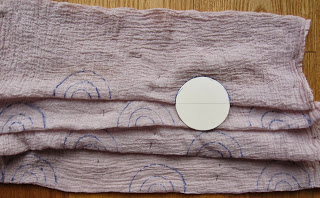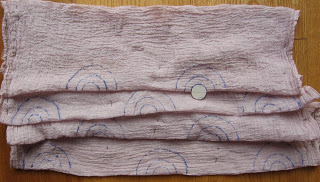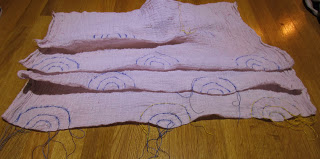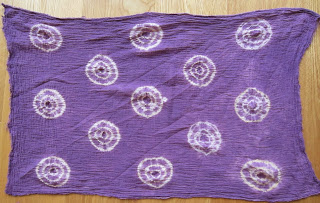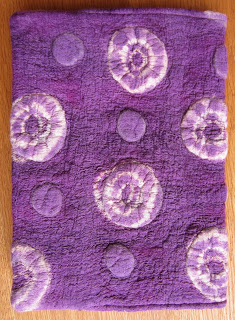It is a bit of a stretch to call this a tutorial as I am still exploring this method of dyeing myself but I thought I would share the process so you can have a go too if interested. I think of shibori as being tie-dye for grown ups, the principal of what we are doing is the same, we are creating areas where the fabric is so tightly bound that the dye cannot penetrate and those areas retain the colour of the base fabric. There are many different shibori methods including folding, clamping, wrapping around pipes, using elastic bands and stitching. Here I have used stitches and gathering the fabric to form a resist.
I am using a pale pink / purple piece of cotton scrim (this was dyed in the left over dye after some rainbow dyeing, described in another post).
I hand-stitched semi-circles over a fold (I also tried machine stitching but found it difficult to get a smooth curve and it was far more difficult to remove the machine stitching afterwards). I started by folding my fabric at regular lengths and then pinned it into place before using a water soluble marker and some templates cut from card to mark out where I will stitch.
Drawing a semi-circle along each fold, first with the large template:
Then the medium sized circle…
And finally the small circle…
Keep going until all of the circles have been stitched, then you are ready to start gathering.
Tie off one end of each line and pull the other end as tightly as you can to gather the fabric and tie off the other end. Repeat this for all the circles.
Now you are ready to dye, I used a packet of hand-dye Dylon but any fibre reactive dye (e.g. Procion MX) will do a good job, just follow the instructions on the packet.
After rinsing you can remove the stitching and dry flat or if you prefer a textured fabric you can remove the stitches once it is dry. I removed mine while it was still wet because I wanted to use this piece as a laminate in felt making. This is what it looked like once dry:
After felting I turned this piece into a large book cover:

